GUYANA | Suspicious Voter Registration Trends Raise Concerns in Guyana

In a Guyana where elections have often been a contentious matter, new data comparing voter registrations to census figures has reignited concerns about the integrity of Guyana’s electoral process.
An analysis of voter registration trends from 1997 to 2020 reveals significant anomalies that warrant scrutiny, particularly in light of legal actions taken by the People’s Progressive Party (PPP) to prevent the cleaning of the voters’ list in 2019.
It should also be noted that while APNU efforts to clean the list were stymied by aggressive legal action by the PPP, in 2015, the PPP government was firmly in control of GECOM activities. It is also worth noting that for the 2015 and 2020 elections, more than 185,000 suspicious new registrants were added to the voter’s list.
In a Guyana where elections have often been a contentious matter, new data comparing voter registrations to census figures has reignited concerns about the integrity of Guyana’s electoral process. An analysis of voter registration trends from 1997 to 2020 reveals significant anomalies that warrant scrutiny, particularly in light of legal actions taken by the People’s Progressive Party (PPP) to prevent the cleaning of the voters’ list in 2019.
It should also be noted that while APNU efforts to clean the list were stymied by aggressive legal action by the PPP, in 2015, the PPP government was firmly in control of GECOM activities. It is also worth noting that for the 2015 and 2020 elections, more than 185,000 suspicious new registrants were added to the voter’s list.
In a Guyana where elections have often been a contentious matter, new data comparing voter registrations to census figures has reignited concerns about the integrity of Guyana’s electoral process. An analysis of voter registration trends from 1997 to 2020 reveals significant anomalies that warrant scrutiny, particularly in light of legal actions taken by the People’s Progressive Party (PPP) to prevent the cleaning of the voters’ list in 2019.
It should also be noted that while APNU efforts to clean the list were stymied by aggressive legal action by the PPP, in 2015, the PPP government was firmly in control of GECOM activities. It is also worth noting that for the 2015 and 2020 elections, more than 185,000 suspicious new registrants were added to the voter’s list.
Alarming Trends Across Regions
The comparison of voter registration data to the 2012 census reveals troubling patterns, particularly in Regions 3, 4, and 6, where registrations have reached or exceeded 90% of the population. These figures stand in stark contrast to the expected norms for voter registration, especially in a country where significant portions of the population are under the voting age or otherwise ineligible.
For example, in Region 3, voter registration increased by 21% from 2015 to 2020, bringing the total registrations to a staggering 94% of the census population. Similarly, Region 4, Guyana’s most populous region and a key battleground in national elections, saw registrations rise to 91% of the census population, with a 14% increase over the same period. These trends are far above what would typically be expected, even accounting for population growth and improved access to registration.

Unexplained Surges in Registration
Perhaps most concerning are the sharp increases in registration numbers in certain regions over short periods. For instance, Region 9, a sparsely populated area, experienced a 26% jump in registrations between 2015 and 2020. Similarly, Region 8 saw a 25% rise during the same timeframe. Such rapid growth in voter registrations, particularly in regions with limited infrastructure and slow population growth, raises questions about the legitimacy of the additions to the voters’ list.
Legal Context and Historical Actions
These findings take on added significance in the context of actions by the PPP in 2019. The party filed legal challenges to prevent the Guyana Elections Commission (GECOM) from removing names from the voters’ list, arguing that such actions could disenfranchise legitimate voters. However, this position contrasts with the PPP’s prior control of GECOM during the 2015 elections, raising questions about whether the resistance to cleaning the list was motivated by concerns over voter fraud or political expediency.
Uniformity Across Regions Suggests Systematic Issues
The analysis also points to a suspicious uniformity in the trends. Across multiple regions, voter registration percentages consistently hover between 70% and 90% of the census population. This consistency suggests a systematic issue rather than organic growth, further underscoring the need for a thorough review of the voters’ list.
Citizens, Investors, Diplomats Must Insist on a Clean Voter’s List
In light of these findings, there is a pressing need for transparency and accountability in Guyana’s electoral system. A forensic audit of the voters’ list, particularly in regions with unusually high registration rates and sharp increases, is imperative. Additionally, the processes used to add names to the list must be reviewed to ensure they meet the highest standards of integrity.
The integrity of elections is the cornerstone of democracy. As Guyana prepares for future electoral contests, it is vital that all stakeholders work together to ensure the accuracy and credibility of the voters’ list. Anything less risks undermining public confidence in the democratic process and the legitimacy of election outcomes.
Furthermore the discrepancies in voter registration figures compared to census data, coupled with historical resistance to cleaning the voters’ list, present a serious challenge to the credibility of Guyana’s electoral system. Only through rigorous investigation and reform can the nation ensure that its democracy remains robust and trusted by all its citizens.
Article courtesy of The Village VOICE
-30-

 En
En  Ar
Ar